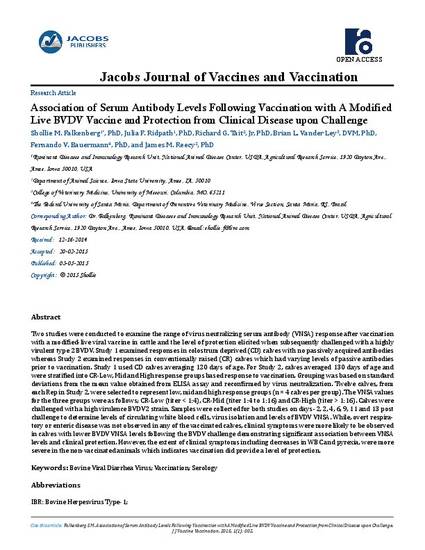
Two studies were conducted to examine the range of virus neutralizing serum antibody (VNSA) response after vaccination with a modified-live viral vaccine in cattle and the level of protection elicited when subsequently challenged with a highly virulent type 2 BVDV. Study 1 examined responses in colostrum deprived (CD) calves with no passively acquired antibodies whereas Study 2 examined responses in conventionally raised (CR) calves which had varying levels of passive antibodies prior to vaccination. Study 1 used CD calves averaging 120 days of age. For Study 2, calves averaged 130 days of age and were stratified into CR-Low, Mid and High response groups based response to vaccination. Grouping was based on standard deviations from the mean value obtained from ELISA assay and reconfirmed by virus neutralization. Twelve calves, from each Rep in Study 2, were selected to represent low, mid and high response groups (n = 4 calves per group). The VNSA values for the three groups were as follows; CR-Low (titer < 1:4), CR-Mid (titer 1:4 to 1:16) and CR-High (titer > 1:16). Calves were challenged with a high virulence BVDV2 strain. Samples were collected for both studies on days -2, 2, 4, 6, 9, 11 and 13 post challenge to determine levels of circulating white blood cells, virus isolation and levels of BVDV VNSA. While, overt respiratory or enteric disease was not observed in any of the vaccinated calves, clinical symptoms were more likely to be observed in calves with lower BVDV VNSA levels following the BVDV challenge demonstrating significant association between VNSA levels and clinical protection. However, the extent of clinical symptoms including decreases in WBC and pyrexia, were more severe in the non-vaccinated animals which indicates vaccination did provide a level of protection.
Available at: http://works.bepress.com/james_reecy/89/

This article is from Jacob Journal of Vaccines and Vaccination 1 (2015): 002.